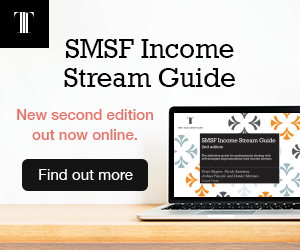 |
| Peter Slegers, CTA and Nicole Santinon |
Last year saw the biggest changes to the taxation of superannuation in almost a decade.
With subsequent legislative developments and ATO pronouncements, transition to retirement income streams, broader succession planning issues and issues with the transitional CGT relief have become key areas of focus.
Here, Peter Slegers, CTA and Nicole Santinon, authors of the SMSF Income Stream Guide, and Joshua Pascale and Daniel Marateo, who joined them in producing the new second edition of the Guide, tell us about these issues facing advisers.
It is now almost a year since the Fair and Sustainable Superannuation reforms came into effect. Can you summarise the feeling amongst advisers?
The transfer balance cap and associated reforms have certainly changed the landscape for SMSF professionals. Not only have the reforms placed considerable limits on the scale of the tax advantages associated with income streams, but it is now more difficult than ever for members to maximise the value in their fund prior to commencing an income stream.
Nonetheless, our view is that the commencement, management and planning activities associated with income streams have arguably increased in importance.
Superannuation still remains the most tax effective vehicle for the accumulation of wealth in Australia and advisers must remain alive to the opportunities and strategies available to maximise outcomes under the transfer balance cap regime.
In the second edition of the SMSF Income Stream Guide we address a number of new and emerging strategies associated with the transfer balance cap measures.
 |
| Daniel Marateo and Joshua Pascale |
are some of the issues advisers need to have on their radar when dealing with
the transitional CGT relief measures?
30 June is fast approaching, so SMSF practitioners will need to assist clients in making critical decisions in relation to the CGT relief to ensure they achieve optimal outcomes for their fund. In our view, it is not sufficient to simply lodge written choices with the ATO.
Careful thought must be given to the specific assets that will be subject to the cost base reset and/or CGT deferral. Some of the issues advisers should have on their radar include:
- Correctly identifying the approach (proportionate or segregated) adopted by the fund to determining its earnings tax exemption in the pre-commencement period. This includes being aware of the ATO view that a fund that has 100% of its assets supporting the payment of superannuation income streams is adopting the segregated assets approach. Correct identification of the approach is critical as the specific eligibility criteria, as well as the outcomes of applying the relief, differ depending on the method adopted by the fund.
- Whether it would be beneficial to choose not to apply the relief, for example, where a fund has adopted the proportionate approach before 1 July 2017 and expects its exempt proportion to increase after 1 July 2017.
- Whether there are circumstances where a favourable outcome can be achieved by choosing to apply the relief under the proportionate approach in respect of assets with unrealised capital losses.
- Ensuring careful planning in relation to the ongoing management of the fund. For example, where relief is chosen in respect of units in a unit trust that owns real property with an unrealised capital gain, it may be necessary to consider winding up the unit trust in the year of the disposal of the underlying land to manage the tax outcomes for the fund.
A detailed consideration of the operation of the transitional CGT relief provisions, including tips, traps and new case studies, is contained in chapter 11 of the new edition of the Guide (as well as in chapter five, in respect of TRISs).
Trustees and advisers should be a little more comfortable with the transfer balance cap regime by now, but are there still ongoing issues advisers should consider?
With pre-1 July 2017 compliance activities now firmly in the rear view mirror, there are a number of ongoing issues associated with the transfer balance cap regime that trustees and advisers should turn their minds to. Some particular areas attracting attention include:
- dealings with transition to retirement income streams, including a TRIS entering into retirement phase (giving rise to a transfer balance account credit) and associated planning issues;
- properly appraising clients’ succession planning issues, particularly in relation to reversionary income streams following death; and
- maximising outcomes under the transfer balance cap through, for example, asset allocation in the fund (as opposed to segregation for tax purposes) or the use of dual fund strategies.
We’ve seen significant tax and superannuation law changes to
TRISs, creating a range of issues for advisers to deal with. Can you touch on a
couple of issues that have received updates in the new edition?
Chapter five of the Guide is entirely devoted to TRISs, and in the second edition it has been updated to comprehensively deal with the treatment of TRISs under the new taxation regime for SMSFs. This includes:
- planning for and appropriately managing a TRIS where the recipient has or will satisfy a condition of release with a nil cashing restriction;
- the pros and cons of commencing a TRIS in the post-30 June 2017 environment (including TRIS strategies to manage the taxable and tax-free components of a member’s account balance); and
- Treasury’s view on a TRIS continuing to have TRIS status once it becomes a retirement phase income stream.
Can you tell us a little about why Treasury’s view that a TRIS continues to have TRIS status even when it becomes a retirement phase income stream is seen as controversial?
This Treasury (and ATO) view may be seen as controversial in light of the industry practice before the enactment of the Fair and Sustainable Superannuation reforms. This practice was to treat a TRIS as having converted to a standard unrestricted account-based pension upon the member satisfying a subsequent condition of release.
- under the FSS legislation as first enacted, a TRIS was excluded from being a retirement phase income stream. This would have required TRIS recipients to commute their TRIS and commence an account-based pension in order to enter retirement phase (which may have had unintended adverse consequences); and
- it would have precluded the ability to pay a TRIS as a reversionary pension to a recipient who had not themselves satisfied a condition of release (which contrasts with the position in respect of account-based pensions).
The reforms have had a number of knock-on effects for succession planning, including in the use of reversionary pensions. Can you tell us a little about some of these issues?
Succession planning for superannuation balances remains critically important in the transfer balance cap environment. Ensuring that pensions that are intended to be reversionary are documented as such will be critical to ensuring that a reversionary pensioner has the benefit of the 12-month grace period from the death of the primary pensioner to make important commercial and taxation decisions. These decisions include, for example:
- whether to internally or externally commute the recipient’s existing pension (if any) in order to comply with the recipient’s transfer balance cap;
- how to maximise the use of the recipient’s transfer balance cap;
- how to obtain a favourable outcome in relation to the taxable and tax-free components of the benefits left in the fund; and
- how to deal with assets such as real property, that is, whether property should be converted to cash or paid in specie (bearing in mind potential CGT and stamp duty costs).
To minimise the risk of disputes arising, it is also important to ensure that all of a client’s succession planning documentation is consistent, including pension terms, binding death benefit nominations, the governing rules for the fund and the member’s Will.
The second edition of the Guide contains a number of new succession planning issues and strategies, including:
- the use of enduring power of attorney arrangements to deal with pensioner incapacity and death benefits planning; and
- case law developments on binding de
ath benefit nominations, commentary on the meaning of a “dependant” and planning tips to bring greater certainty to the cessation of income streams upon death.
We also consider death benefits and superannuation succession planning in detail in Chapters nine and ten of the Guide.









